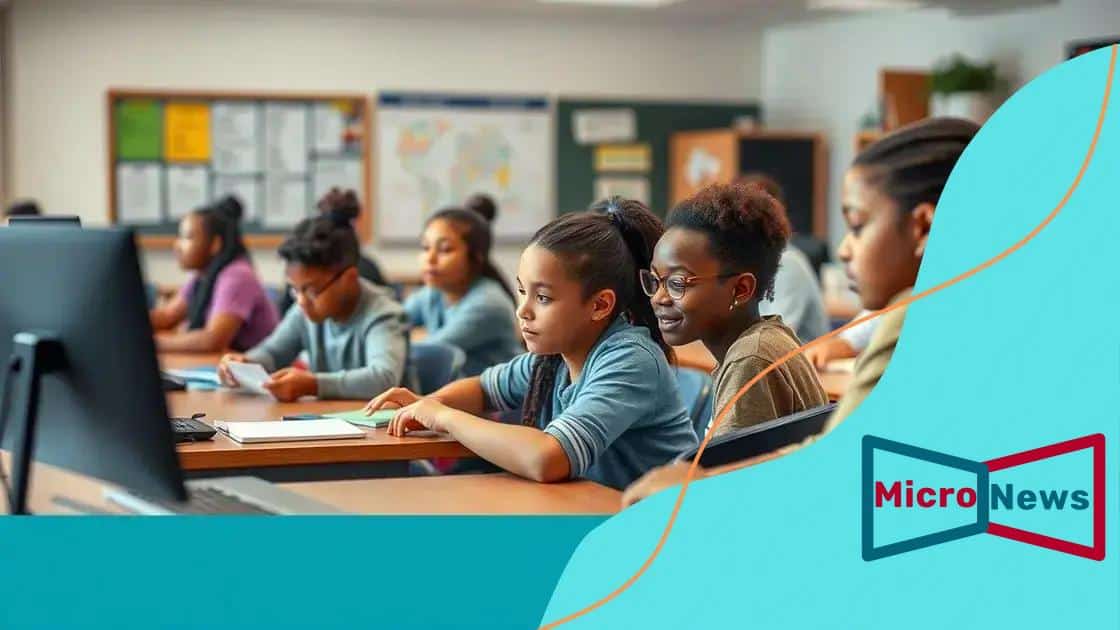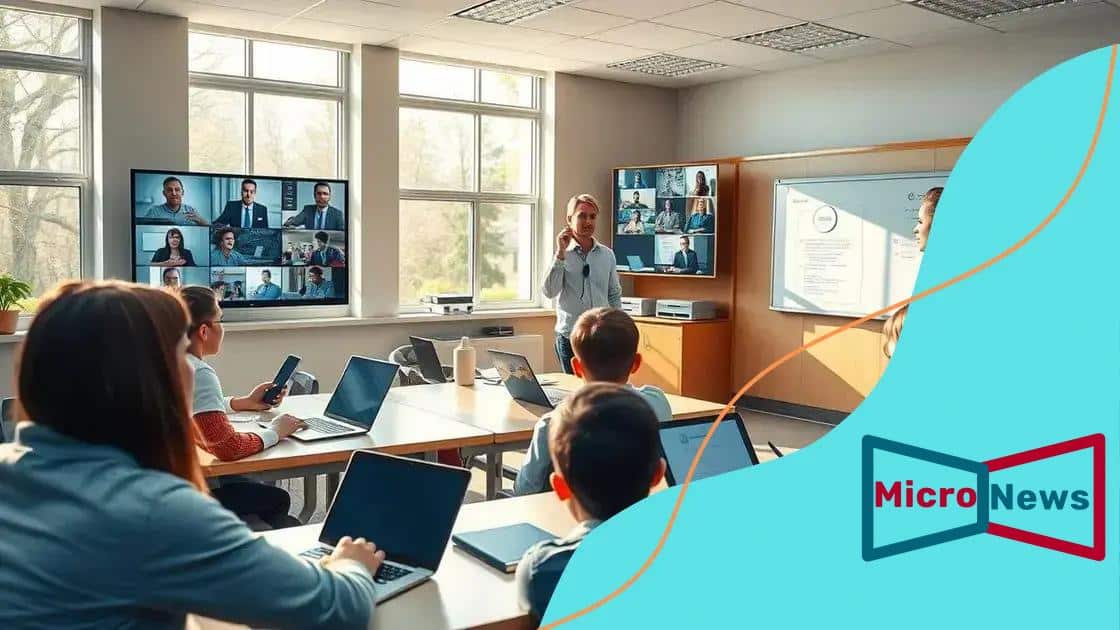Hybrid education models post-pandemic: a guide

Hybrid education models combine in-person and online learning, offering flexibility, personalization, and improved engagement while facing challenges like technology access and effective teaching strategies.
Hybrid education models post-pandemic have emerged as a transformative approach to learning. As schools adapt to new realities, these models offer flexibility and opportunities that traditional methods may lack. What can you expect from this evolving landscape?
Understanding hybrid education: a definition
Understanding hybrid education is essential in today’s learning landscape. This model combines traditional in-person classes with online learning components, creating a flexible approach that benefits both students and educators. Many institutions are now embracing this method to enhance the learning experience.
What is Hybrid Education?
Hybrid education refers to a teaching approach that integrates face-to-face instruction with digital resources. It allows students to participate in a variety of learning environments, accommodating different learning styles and schedules. As the pandemic reshapes educational paradigms, understanding hybrid education becomes more relevant.
Key Characteristics of Hybrid Education
- Flexibility: Students can choose to attend classes in person or online.
- Personalized Learning: This model supports differentiated instruction tailored to individual needs.
- Enhanced Engagement: Online tools can boost student interaction, making learning more dynamic.
- Accessibility: Learners can access materials anytime and anywhere, breaking down geographical barriers.
Hybrid education not only addresses the challenges posed by the pandemic but also opens doors for innovative teaching methods. Institutions are incorporating more technology into their curricula, presenting opportunities for richer educational experiences.
In addition to these benefits, hybrid education promotes collaboration among students and teachers. Educators can facilitate group projects and discussions both in person and online. This model encourages active participation, fostering a sense of community among learners.
As we continue to navigate the evolving educational landscape, the hybrid education model shows great promise. It can cater to diverse student needs while enhancing the teaching process.
Benefits of hybrid models for students and teachers
The benefits of hybrid models for students and teachers are significant and varied. These models combine traditional in-person learning with online components, creating a more adaptable and inclusive education system.
Advantages for Students
Students gain flexibility and control over their learning environments. They can choose when and how they learn best, which can lead to improved engagement. Additionally, hybrid models often leverage technology, providing students with access to a wide range of resources and materials.
Key Student Benefits
- Individualized Learning: Students can progress at their own pace, focusing on areas where they need more support.
- Increased Engagement: Combining different learning styles encourages active participation and maintains interest.
- Better Time Management: Students can better manage their time, balancing schoolwork with other responsibilities.
- Accessibility: Learning materials are readily accessible online, making it easier for students to review content at their convenience.
For teachers, hybrid education provides opportunities to innovate their teaching methods. It encourages collaboration and communication, which can enhance the overall learning experience.
Advantages for Teachers
Teachers can reach more students by offering varied instructional methods and can tailor their approaches to meet diverse needs. This flexibility also allows for more effective communication with families, as they can share updates through online platforms.
In a hybrid model, teachers might find that they can enhance their professional development as well. Access to useful online training resources and workshops can enable them to refine their skills and knowledge.
Overall, the hybrid education model supports a collaborative environment that benefits both students and teachers. By embracing this method, educational institutions can foster a more dynamic and responsive learning atmosphere.
Tips for effective implementation of hybrid education

Implementing hybrid education effectively requires careful planning and strategy. Schools must focus on creating a balanced approach that meets the needs of all students while utilizing the strengths of both in-person and online learning.
Establish Clear Objectives
Before rolling out a hybrid model, it is crucial to define clear objectives. Knowing what the school aims to achieve helps guide the implementation process. This can involve enhancing student engagement or improving academic outcomes.
Key Implementation Tips
- Train Educators: Provide training sessions for teachers to help them understand how to blend in-person and online teaching.
- Utilize Technology: Select user-friendly tools and platforms that facilitate seamless communication and learning.
- Engage Students: Foster a culture of connection by encouraging discussions and collaborations in both formats.
- Gather Feedback: Regularly collect feedback from students and parents to identify strengths and areas for improvement.
In addition to setting clear objectives, schools should prioritize communication. Keeping students and parents updated on any changes or expectations can enhance trust and cooperation. Additionally, using platforms that allow for easy messaging and announcements can make a significant difference.
Monitoring progress is equally important. Educators should analyze data on student performance to adjust teaching methods and content delivery. By understanding what works best, they can continuously improve the hybrid experience.
Another vital aspect is to create an inclusive environment. Ensure that all students have access to the necessary resources and support, whether they are learning online or attending in person. This helps to bridge any gaps and promotes equal opportunities for everyone.
Challenges educators face with hybrid models
While hybrid education models offer many benefits, they also present several challenges for educators. Understanding these difficulties is crucial for effective implementation.
Adapting Teaching Methods
One of the main challenges is adapting traditional teaching methods to fit a hybrid model. Educators must learn to integrate technology into their lesson plans while maintaining student engagement. This often requires additional training and support.
Key Challenges Faced
- Technology Issues: Not all students have equal access to devices or reliable internet, leading to disparities in learning opportunities.
- Classroom Management: Managing a classroom that includes both in-person and online students can be tricky, as it requires different strategies and approaches.
- Time Constraints: Teachers often feel pressed for time, needing to prepare materials for both formats without sacrificing quality.
- Student Engagement: Keeping both online and in-person students engaged simultaneously can be difficult, as different students may require different approaches.
In addition to these challenges, educators also face the task of assessing student performance effectively. With students learning in different environments, creating fair evaluation methods is essential. This can involve developing new assessments that cater to both audiences.
Communication plays a crucial role in overcoming these hurdles. Teachers need to maintain clear and consistent communication with students and parents to ensure everyone is on the same page. This can help address concerns as they arise and foster a supportive learning environment.
Ultimately, understanding and addressing these challenges is vital for successfully implementing hybrid education models. By being aware of the potential issues, educators can work towards solutions that enhance the learning experience for everyone involved.
Future trends in hybrid education
Future trends in hybrid education suggest exciting possibilities for enhancing the learning experience. As technology evolves, educators are finding new ways to engage students in both online and in-person settings.
Increased Use of Technology
One significant trend is the growing reliance on advanced technology. Virtual reality (VR) and augmented reality (AR) are becoming more common in classrooms. These tools can create immersive experiences that make learning more interactive.
Key Trends to Watch
- Personalized Learning: Tailoring education to meet individual student needs is becoming a priority. Adaptive learning platforms can help achieve this goal.
- Data-Driven Decision Making: Educators will increasingly use data analytics to monitor student progress and outcomes, allowing for more informed teaching strategies.
- Blended Learning Models: A mix of different teaching styles will likely prevail, blending synchronous and asynchronous learning to maximize engagement.
- Focus on Social-Emotional Learning: Addressing students’ emotional and social needs will gain prominence, ensuring a well-rounded education.
Moreover, educators will see a rise in collaboration tools that facilitate communication between students and teachers. This can build a stronger sense of community, even in a hybrid environment. For instance, chat platforms and video conferencing tools will make it easier to connect and share ideas.
As we look forward to the future, training for educators will also become vital. Professional development will focus on equipping teachers with the skills needed to adapt to new technologies and teaching methodologies effectively.
Ultimately, the evolution of hybrid education will aim to create more flexible and responsive learning environments. By embracing these trends, schools can better prepare students for success in a rapidly changing world.
FAQ – Frequently Asked Questions about Hybrid Education Models
What are the key benefits of hybrid education models?
Hybrid education models provide flexibility, personalized learning opportunities, and access to diverse resources for both students and teachers.
What challenges do educators face with hybrid learning?
Challenges include managing technology access, engaging both in-person and online students, and adapting teaching methods to diverse formats.
How can technology enhance hybrid education?
Technology can facilitate interactive learning experiences, enable personalized instruction, and improve communication between teachers and students.
What are the future trends in hybrid education?
Future trends include increased use of virtual reality, adaptive learning technologies, and a focus on social-emotional learning to support student well-being.





